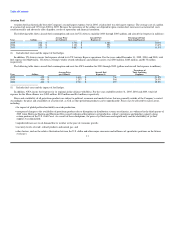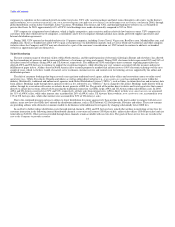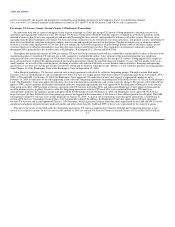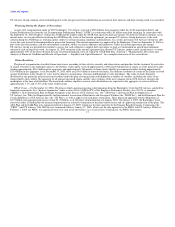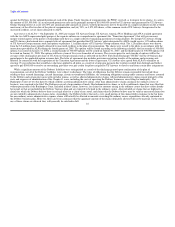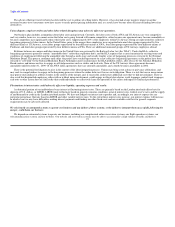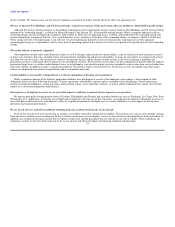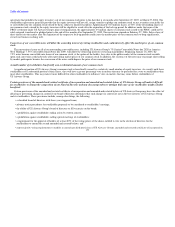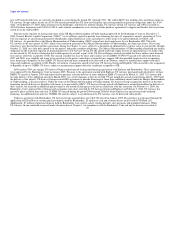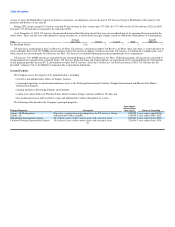US Airways 2005 Annual Report Download - page 27
Download and view the complete annual report
Please find page 27 of the 2005 US Airways annual report below. You can navigate through the pages in the report by either clicking on the pages listed below, or by using the keyword search tool below to find specific information within the annual report.
Table of Contents
The advent of Internet travel websites has lowered the cost to airlines of selling tickets. However, it has also had a large negative impact on airline
revenues because travel consumers now have access to nearly perfect pricing information and, as a result, have become more efficient at finding lower fare
alternatives.
Union disputes, employee strikes and other labor-related disruptions may adversely affect our operations.
Our business plan includes assumptions about labor costs going forward. Currently, the labor costs of both AWA and US Airways are very competitive
and very similar; however, we cannot assure that labor costs going forward will remain competitive, either because our agreements may become amendable or
because competitors may significantly reduce their labor costs. Approximately 80% of the employees within US Airways Group are represented for collective
bargaining purposes by labor unions. In the United States, prior to the merger these employees were organized into nine labor groups represented by five
different unions at US Airways, seven labor groups represented by four different unions at AWA, four labor groups represented by four different unions at
Piedmont, and four labor groups represented by four different unions at PSA. There are additional unionized groups of US Airways employees abroad.
Relations between air carriers and labor unions in the United States are governed by the Railway Labor Act (the "RLA"). Under the RLA, collective
bargaining agreements generally contain "amendable dates" rather than expiration dates, and the RLA requires that a carrier maintain the existing terms and
conditions of employment following the amendable date through a multi-stage and usually lengthy series of bargaining processes overseen by the National
Mediation Board. This process continues until either the parties have reached agreement on a new collective bargaining agreement, or the parties have been
released to "self-help" by the National Mediation Board. Although in most circumstances the RLA prohibits strikes, after release by the National Mediation
Board carriers and unions are free to engage in self-help measures such as strikes and lock-outs. None of the US Airways labor agreements becomes
amendable until December 31, 2009. Of the AWA labor agreements, three are currently amendable, and a fourth becomes amendable in 2006.
There is the potential for litigation to arise in the context of the labor integration process. Unions may bring court actions or grievance arbitrations, and
may seek to compel airlines to engage in the bargaining processes where the airline believes it has no such obligation. There is a risk that one or more unions
may pursue such judicial or arbitral avenues in the context of the merger, and, if successful, could create additional costs that we did not anticipate. There is
also a risk that disgruntled employees, either with or without union involvement, could engage in illegal slow-downs, work stoppages, partial work stoppages,
sick-outs or other action short of a full strike that could individually or collectively harm the operation of the airline and impair its financial performance.
Fluctuations in interest rates could adversely affect our liquidity, operating expenses and results.
A substantial portion of our indebtedness bears interest at fluctuating interest rates. These are primarily based on the London interbank offered rate for
deposits of U.S. dollars, or LIBOR. LIBOR tends to fluctuate based on general economic conditions, general interest rates, federal reserve rates and the supply
of and demand for credit in the London interbank market. We have not hedged our interest rate exposure and, accordingly, our interest expense for any
particular period may fluctuate based on LIBOR and other variable interest rates. To the extent these interest rates increase, our interest expense will increase,
in which event we may have difficulties making interest payments and funding our other fixed costs and our available cash flow for general corporate
requirements may be adversely affected.
We rely heavily on automated systems to operate our business and any failure of these systems, or the failure to integrate them successfully following the
merger, could harm our business.
We depend on automated systems to operate our business, including our computerized airline reservation systems, our flight operations systems, our
telecommunication systems and our websites. Our website and reservation systems must be able to accommodate a high volume of traffic and deliver
21


